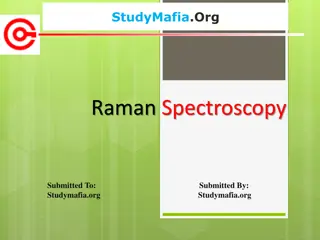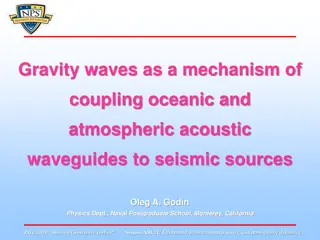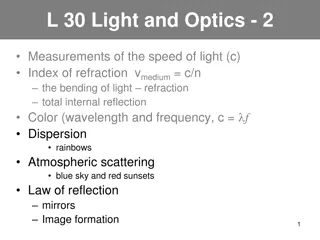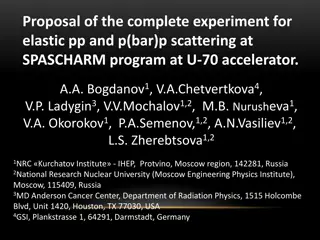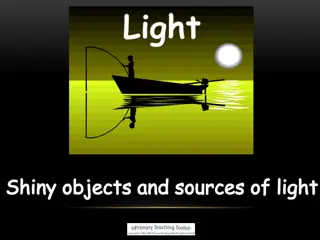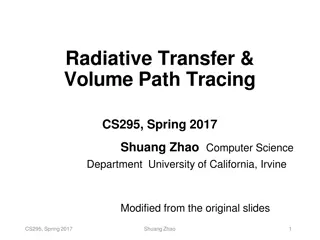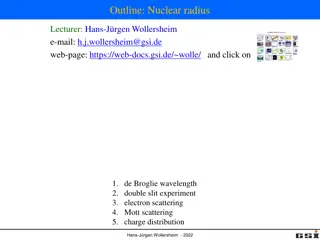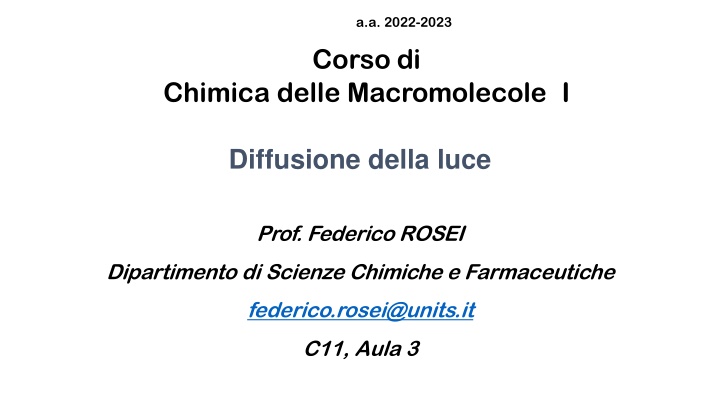
Light Scattering in Polymer Characterization
Explore the principles of light scattering for polymer characterization, including static and dynamic forms, elastic and inelastic scattering, and measurement schemes. Learn how light scattering determines polymer size, distribution, and molecular weight in solution, aiding in intricate analyses of macromolecules.
Download Presentation

Please find below an Image/Link to download the presentation.
The content on the website is provided AS IS for your information and personal use only. It may not be sold, licensed, or shared on other websites without obtaining consent from the author. If you encounter any issues during the download, it is possible that the publisher has removed the file from their server.
You are allowed to download the files provided on this website for personal or commercial use, subject to the condition that they are used lawfully. All files are the property of their respective owners.
The content on the website is provided AS IS for your information and personal use only. It may not be sold, licensed, or shared on other websites without obtaining consent from the author.
E N D
Presentation Transcript
a.a. 2022-2023 Corso di Chimica delle Macromolecole I Diffusione della luce Prof. Federico ROSEI Dipartimento di Scienze Chimiche e Farmaceutiche federico.rosei@units.it C11, Aula 3
Light scattering for polymer characterization Based on the scattering of light by molecules in the sample Determines the size, size distribution and molecular weight of polymers in solution Exists in two forms: Dynamic LS: size & size distribution Static LS: molecular weight, radius of gyration and second virial coefficient
Light scattering Inelastic Radiation is absorbed and emitted with a difference in energy Rayleigh scattering If wavelength of radiation is larger than the radius of particles Light scattering Elastic Radiation is absorbed and emitted without a difference in energy Large particle scattering If wavelength of radiation is smaller than the radius of particles
Light scattering measurement scheme I Geometria di un esperimento di diffusione: I l intensit della radiazione incidente I l intensit della radiazione diffusa all angolo l angolo di diffusione r la distanza del rivelatore dai centri di diffusione.
Elastic scattering R = Rayleigh scattering r = radius of particle I = intensity of light source I = intensity of scattered light k=constant which is a function of angle, wavelength, refractive index and distance between the detector and the particle SMALL PARTICLES *Rayleigh scattering* I = kr6 R = I LARGE PARTICLES Scattering increases in the forward direction and decreases in the backward direction because of constructive and destructive interference caused by intramolecule scattering
Gli esperimenti di diffusione possono essere divisi in due grandi categorie Diffusione statica dellaluce Static Light Scattering (LS) Diffusionedinamica dellaluce Dynamic Light Scattering (DLS) Diffusione della luce da una soluzione mediata nel tempo in funzione dell angolo di diffusione e della concentrazione (polimerica) Variazione della diffusione della luce da una soluzione (polimerica) in funzione del tempo, causata dai moti browniani delle molecole in soluzione, oltre dell angolo di diffusione e della concentrazione sub-micrometer ( m) Best for particles <1 nm to 1 m
Dynamic Light Scattering (DLS) Advantages: Noninvasive, nondestructive, relatively fast, versatile, sensitive to aggregates Based on the Brownian motion experienced by the molecules in solution Interference: large particle scatter light more slowly than smaller ones Drawbacks: Fairly poor resolution, not sensitive to chemical nature, relatively complex theory, particles are not visualized
Moto browniano Con il semplice ausilio di un microscopio ottico si osserva una piccola particella immersa in acqua: questa tutt'altro che ferma, ma animata da un movimento perfettamentedisordinato. Tale fenomeno viene denominato moto browniano, in onore del botanico inglese Robert Brown, che lo osserv chiaramente per la prima volta nel 1827. Il moto browniano agli albori della sua scoperta dest poco interesse, ma in breve tempo dimostr smentire tutte le spiegazioni proposte basate sulle conoscenze dell'epoca Il fenomeno si presenta in tutti i fluidi, con una attivit inversamente proporzionale alla viscosit del fluido in questione. Non riconducibile a correnti di convezione termica o alle vibrazioni del supporto del recipiente. Tutt'al pi si somma a questi moti macroscopici. La caratteristica pi sorpendente che il moto non si arresta mai, eterno e spontaneo .
DLS measures the difference in intensity with time Correlation of signals taken at different time points Signal at t=0 and t=1, the incremental difference between the two time points is called DELAY TIME If is short, correlation is close to 1 (particles have no time to move) If is long, correlation is close to 0 (particles have ton of time to move) Between correlation of 0 and of 1, there is exponential decay
The correlation function ??= ? [ ? + ?? ??] LARGE PARTICLES ? = ??? D = translational diffusion coefficient ? = ??? / ? ????/? n = refraction index ? = ????? ????????? ? = scatter angle A = baseline B = intercept SMALL PARTICLES
Plotting G vs ??2 The measurement Se le particelle sono grandi, il segnale cambier lentamente e la correlazione persister a lungo. Se le particelle sono piccole e si muovono rapidamente, la correlazione decadr pi rapidamente. Il momento in cui la correlazione inizia a decadere significativamente indice della dimensionemedia del campione. The correlation curve Pi la curva ripida, pi il campione monodisperso. Al contrario, pi allargata diventa la curva di decadimento, maggiore la polidispersit delcampione.
Measuring particle size The Stokes-Einstein equation was derived by Einstein in his PhD thesis for the diffusion coefficient of a Stokes particle undergoing Brownian motion Three principles put together resulted in the Stokes-Einstein equation: Stoke s Law (frictional force) ? = 6???? Van tHoff s Law (osmotic pressure) Diffusion equation ?? ??2 From this could be derived an equation to correlate the size of a particle (Hd, defined as the hydrodynamic diameter because it refers to a particle moving in a fluid) and the translational diffusion coefficient (D) ??= ??2? = iCRT ?? Hd = hydrodynamic diameter k = Boltzmann s constant T = absolute temperature ? = viscosity ?? = ????
Hydrodynamic diameter The diameter that is obtained by this technique is the diameter of a sphere that has the same translational diffusion coefficient as the particle.
Effect of ions on the hydrodynamic diameter: the importance of calibration
Fundamentals Measures the intensity of scattered light at different concentrations and angles Uses derivations of the Rayleigh scattering equation to determine: the molecular weightM the gyration radius Rg (root mean square of mass-weighted distances of all subvolumes in a particle from the centre of mass AKA the size) the second virial coefficient A2(a thermodynamic term indicating the degree to which a polymer solution differs from an ideal solution by taking into account polymer-solvent and polymer-polymer interactions) Assumes that each photon is scattered only once so the sufficient dilution of the solution is important
Light scattering measurement scheme I Geometria di un esperimento di diffusione: I l intensit della radiazione incidente I l intensit della radiazione diffusa all angolo l angolo di diffusione r la distanza del rivelatore dai centri di diffusione.
Per descrivere quantitativamente lintensit diffusa in funzione delle variabili del sistema ( , Rg, ) opportuno porre delle condizioni semplificative: 1. La soluzione polimerica infinitamente diluita (cio le distanze tra centri di una stessa catena sono molto pi piccole di quelle tra catene diverse). 2. L'orientazione della catena statistica rispetto alla radiazione incidente. 3. La radiazione monocromatica e polarizzata. 4. Non esiste alcun fenomeno di assorbimento della radiazione. 5. L'indice di rifrazione del mezzo omogeneo (quello del solvente). 6. Non si hanno fenomeni di diffusione multipla, cio la radiazione diffusa vieneintegralmente misurata.
Methods of analysis Zimm Plot Guinier Plot R = Rayleigh scattering r = radius of particle I = intensity of light source I = intensity of scattered light k=constant which is a function of angle, wavelength, refractive index and distance between the detector and the particle Need to remember: I I = kr6 R = I I
Zimm Plot ??= ?????????? ????? dn/dc = change in refractive index as a function of concentration Na= Avogadro s number ? = wavelength Uses a derivation of the Rayleigh scattering equation to obtain the optical parameter Kc: ?(?? ?? = ????? ??)?/Na?? M = molecular weight C = concentration A2 = second virial coefficient From this, the Zimm equation is obtained: ?? ? = ? ? ? +? ????? ? + ???? Remember from the correlation function: ? = ??? / ? ????/?
Calculating size and mass 1. Take measurements of intensity at different concentrations and angles (brown dots) 2. Extrapolate to concentration = 0 (blue line) and angle = 0 (green line) If c=0 ?? ? = ? ? ? +? ????? ? + ???? then the slope of the blue line = ?? ??= 1 ?(1 +1 3?2?? 2) with an intercept = 1/M ?2 Calibration constant The calibration constant is chosen to spread out the plot and give equal weights to each variable
Calculating second virial coefficient If =0 ?? ? = ? ? ? +? ????? ? + ???? then the slope of the green line = ?? ??= 1 ?+ 2?2? with an intercept = 1/M ?2 Calibration constant
Guinier Plot Used to obtain Rg Ln I (q) For q, remember the correlation function in the previous section! Scattered intensity is plotted as a function of the angle
https://chem.libretexts.org/Bookshelves/Analytical_Chemistry/Instrumental_Analysis_(LibreTexts)/34%3A_P article_Size_Determination/34.05%3A_Measuring_Particle_Size_Using_Light_Scattering https://macro.lsu.edu>howto>Guinier https://jordilabs.com/blog/particle-analysis-dls/ https://www.thermopedia.com/content/1156/ https://www.chem.uci.edu/~dmitryf/manuals/Fundamentals/DLS%20concept.pdf https://www.eng.uc.edu/~beaucag/Classes/Properties/ZimmEquationandRPAFunction.pdf http://www.chem.cmu.edu/groups/Berry/scattering98.pdf https://theanalyticalscientist.com/fileadmin/tas/app-notes/PDFs/Tosoh-w20i16a-Whitepaper-Lens.pdf https://wiki.anton-paar.com/en/molecular-mass-measurement-using-static-light-scattering/ Presentazioni Urbani

